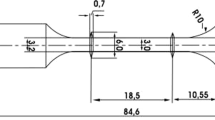Abstract
Stretch-flangeability is one of important formability parameters of thin steel sheets used in the automotive industry. There have been many attempts to predict hole expansion ratio (HER), a typical term to evaluate stretch-flangeability, using uniaxial tensile properties for convenience. This paper suggests a new approach that uses total elongation and average normal anisotropy to predict HER of thin steel sheets. The method provides a good linear relationship between HER of the machined hole and the predictive variables in a variety of materials with different microstructures obtained using different processing methods. The HER of the punched hole was also well predicted using the similar approach, which reflected only the portion of post uniform elongation. The physical meaning drawn by our approach successfully explained the poor HER of austenitic steels despite their considerable elongation. The proposed method to predict HER is simple and cost-effective, so it will be useful in industry. In addition, the model provides a physical explanation of HER, so it will be useful in academia.
Similar content being viewed by others
References
L. Chen, J. K. Kim, S. K. Kim, G. S. Kim, K. G. Chin, and B. C. De Cooman, Steel Res. Int. 81, 552 (2010).
S. K. Paul, M. Mukherjee, S. Kundu, and S. Chandra, Comp. Mater. Sci. 89, 189 (2014).
J. I. Yoon, J. Jung, H. H. Lee, G.-S. Kim, and H. S. Kim, Met. Mater. Int. 22, 1009 (2016).
X. Fang, Z. Fan, B. Ralph, P. Evans, and R. Underhill, J. Mater. Sci. 38, 3877 (2003).
S. K. Paul, J. Mater. Eng. Perform. 23, 3610 (2014).
S. Chatterjee and H. K. D. H. Bhadeshia, Mater. Sci. Tech. 23, 606 (2007).
S. K. De, A. Deva, S. Mukhopadhyay, and B. K. Jha, Mater. Manuf. Process. 26, 37 (2011).
X. Chen, H. Jiang, Z. Cui, C. Lian, and C. Lu, Procedia Engineer. 81, 718 (2014).
R. D. Adamczyk and G. M. Michal, J. Applied Metalworking 4, 157 (1986).
B. S. Levy and C. J. Tyne, J. Mater. Eng. Perform. 21, 2147 (2012).
R. J. Comstock, D. K. Scherrer, and R. D. Adamczyk, J. Mater. Eng. Perform. 15, 675 (2006).
K. Chung, N. Ma, T. Park, D. Kim, D. Yoo, and C. Kim, Int. J. Plasticity 27, 1485 (2011).
R. Narayanasamy, C. S. Narayanan, P. Padmanabhan, and T. Venugopalan, Int. J. Adv. Manuf. Tech. 47, 365 (2010).
D. J. Thomas, J. Fail. Anal. Preven. 12, 518 (2012).
K.-I. Mori, Y. Abe, and Y. Suzui, J. Mater. Process. Tech. 210, 653 (2010).
J. I. Yoon, J. Jung, S.-H. Joo, T. J. Song, K.-G. Chin, H. S. Kim, et al. Mater. Lett. 180, 322 (2016).
J.-I. Hamada and H. Inoue, Mater. Trans. 51, 644 (2010).
H. Liu, Z. Liu, and G. Wang, ISIJ Int. 49, 890 (2009).
J.-I. Hamada, N. Ono, and H. Inoue, ISIJ Int. 51, 1740 (2011).
J. Hu, K. Ikeda, and T. Murakami, J. Mater. Process. Tech. 73, 49 (1998).
P. K. C. Venkatsurya, R. D. K. Misra, M. D. Mulholland, M. Manohar, and J. E. Hartmann Jr, Mat. Sci. Eng. A 575, 6 (2013).
C. Haase, S. Chowdhury, L. Barrales-Mora, D. Molodov, and G. Gottstein, Metall. Mater. Trans. A 44, 911 (2013).
K. Hasegawa, K. Kawamura, T. Urabe, and Y. Hosoya, ISIJ Int. 44, 603 (2004).
O. Bouaziz, S. Allain, C. P. Scott, P. Cugy, and D. Barbier, Curr. Opin. Solid State Mater. Sci. 15, 141 (2011).
L. Mu, Y. Wang, Y. Zang, and P. M. Araujo Stemler, J. Fail. Anal. Preven. 17, 321 (2017).
C. Ye, J. Chen, C. Xia, and X. Yu, Int. J. Mater. Form. 9, 269 (2016).
K. Zhao, L. Wang, Y. Chang, and J. Yan, Mech. Mater. 92, 107 (2016).
S. Marth, H.-Å. Häggblad, M. Oldenburg, and R. Östlund, J. Mater. Process. Tech. 238, 315 (2016).
Author information
Authors and Affiliations
Corresponding authors
Rights and permissions
About this article
Cite this article
Kim, J.H., Kwon, Y.J., Lee, T. et al. Prediction of hole expansion ratio for various steel sheets based on uniaxial tensile properties. Met. Mater. Int. 24, 187–194 (2018). https://doi.org/10.1007/s12540-017-7288-2
Received:
Accepted:
Published:
Issue Date:
DOI: https://doi.org/10.1007/s12540-017-7288-2




